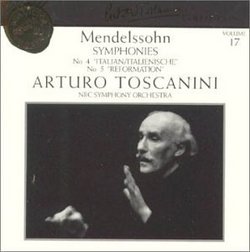| All Artists: Mendelssohn, Toscanini, NBC Title: Felix Mendelssohn: Symphony No. 4 "Italian/Italianische"/Symphony No. 5 "Reformation" (Arturo Toscanini Collection, Volume 17) Members Wishing: 0 Total Copies: 1 Label: RCA Release Date: 8/9/1991 Genre: Classical Styles: Chamber Music, Symphonies Number of Discs: 1 SwapaCD Credits: 1 UPC: 090266028429 |
Search - Mendelssohn, Toscanini, NBC :: Felix Mendelssohn: Symphony No. 4 "Italian/Italianische"/Symphony No. 5 "Reformation" (Arturo Toscanini Collection, Volume 17)
CD Details |
CD ReviewsA Monumental View of the Reformation Symphony 09/19/1998 (5 out of 5 stars) "A rousing success in the "official" Toscanini CD collection!During his last broadcast season, Maestro led the NBC forces on 13 Dec. 1953 in one of the most monumental readings ever committed to disk of the Fifth Symphony of Mendelssohn. In the finale, Toscanini stretches the phrasing of the chorale themes are far as is practical, the musicians digging in with the utmost emphasis and intensity.In a 1938 broadcast (as well as during memorable readings with NBC in '42, '43, '45, and '47) Toscanini played the work with more conventional musical architectonics and less distention. If one can accept this last and most extreme view of the symphony on the grandest celebratory scale, then the performance will be powerfully moving and uplifting. Sound quality of the Carnegie Hall broadcast is better than the original excellent Victor Red Seal LP release.Thus, this valedictory Toscanini performance occupies one far extreme in the continuum of treatment of the work: Beecham's elegance, poise, and exquisitely delicate phrasing in a 1944 78 rpm Victor set (now on Biddulph CD) represents the opposite view, with Masur, Maazel, Paray, and Karajan arrayed along a middle- ground. Bernstein unsuccessfully tries to achieve the monumentality of the Maestro in his otherwise exaggerated and clumsy account with the New York Philharmonic.The "Italian" symphony is, in Toscanini's considered approach, a more serious and sober work, bristling with Victorian melodrama, than it appears to be in the readings of many other conductors. The broadcast of 28 February 1954 -- one of the Maestro's last -- is 'repaired' transparently with inserts from previous rehearsals. In 1938, he graced us with the essential first movement exposition repeat, which allows a few precious measures of unfamiliar transition passages to be enjoyed; here he omits it. By comparison, Beecham is light and airy, emphasizing the fairyland delicacy and felicity of Mendelssohn's scoring, while Maestro's 1954 reading has -- especially in the third movement -- a poignance and introspection that are soon dispelled by the tempestuous outburst of an ultra- brilliant finale. The sound is reproduced with a very slight sense of upper midrange hollowness, but there is no attempt at phony stereo rechanneling (such as the monstrous effects of a typical Iron Needle or Grammophono "refurbishment".)The two short disk mates were originally single- side fillers to 78 rpm sets; the more valuable is the delicious June, 1945 Studio 8-H waxing of the Scherzo from the Octet, op. 20 (here, apparently in the orchestration employed in the appearance of the music in the First Symphony in C Minor: it was the last side of the set of the great Haydn Symphony No. 98 performance on shellac disks. For years during the microgroove era it languished unreleased on American vinyl; we are grateful for its inclusion on this CD as the reading is more nuanced than the chamber- scored version for strings in the 1947 Toscanini broadcast of the complete Octet."
|


 Track Listings (10) - Disc #1
Track Listings (10) - Disc #1![header=[] body=[This CD is available to be requested as disc only.]](/images/attributes/disc.png?v=a4e11020)
![header=[] body=[This CD is available to be requested with the disc and back insert.]](/images/attributes/disc_back.png?v=a4e11020)
![header=[] body=[This CD is available to be requested with the disc and front insert.]](/images/attributes/disc_front.png?v=a4e11020)
![header=[] body=[This CD is available to be requested with the disc, front and back inserts.]](/images/attributes/disc_front_back.png?v=a4e11020)